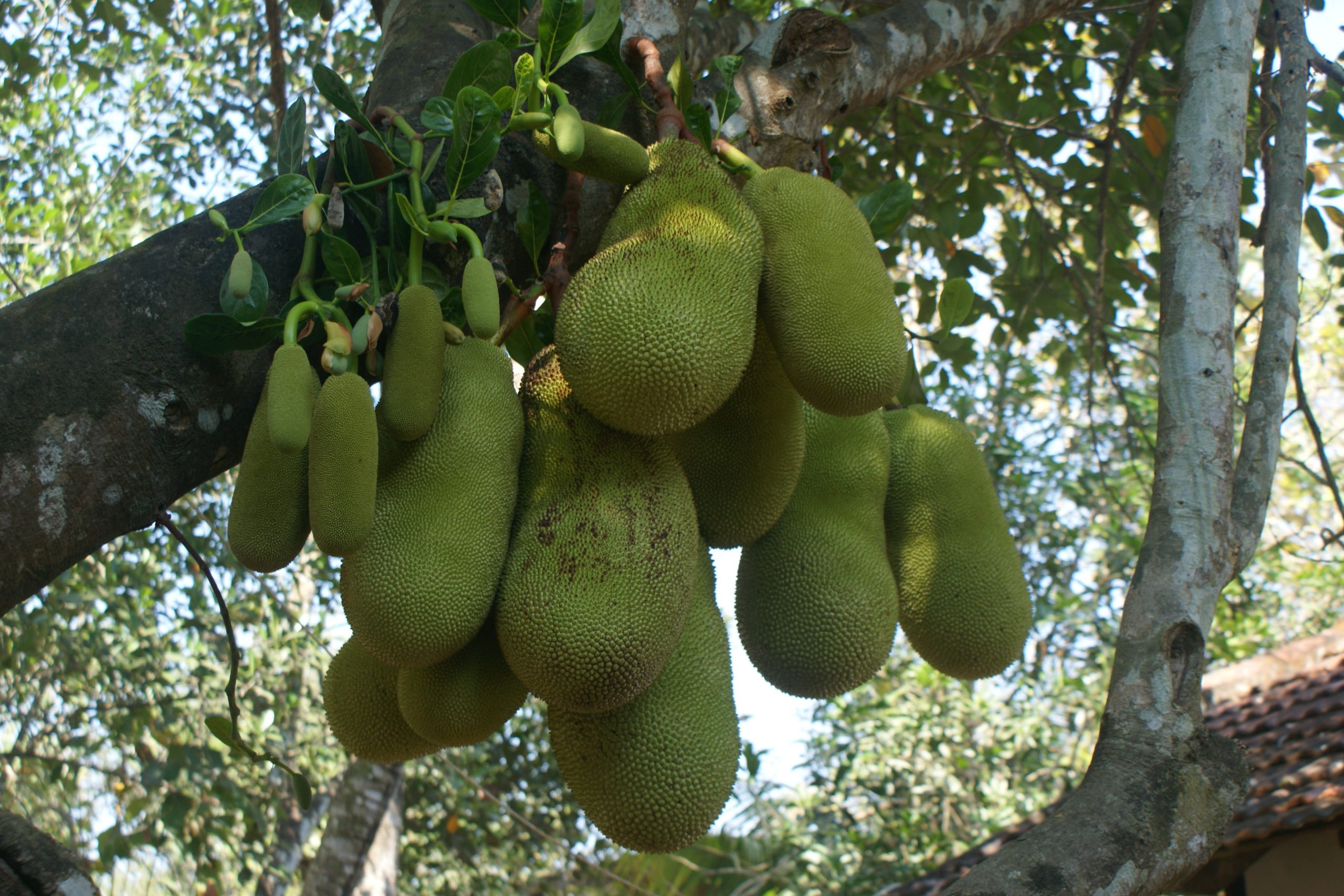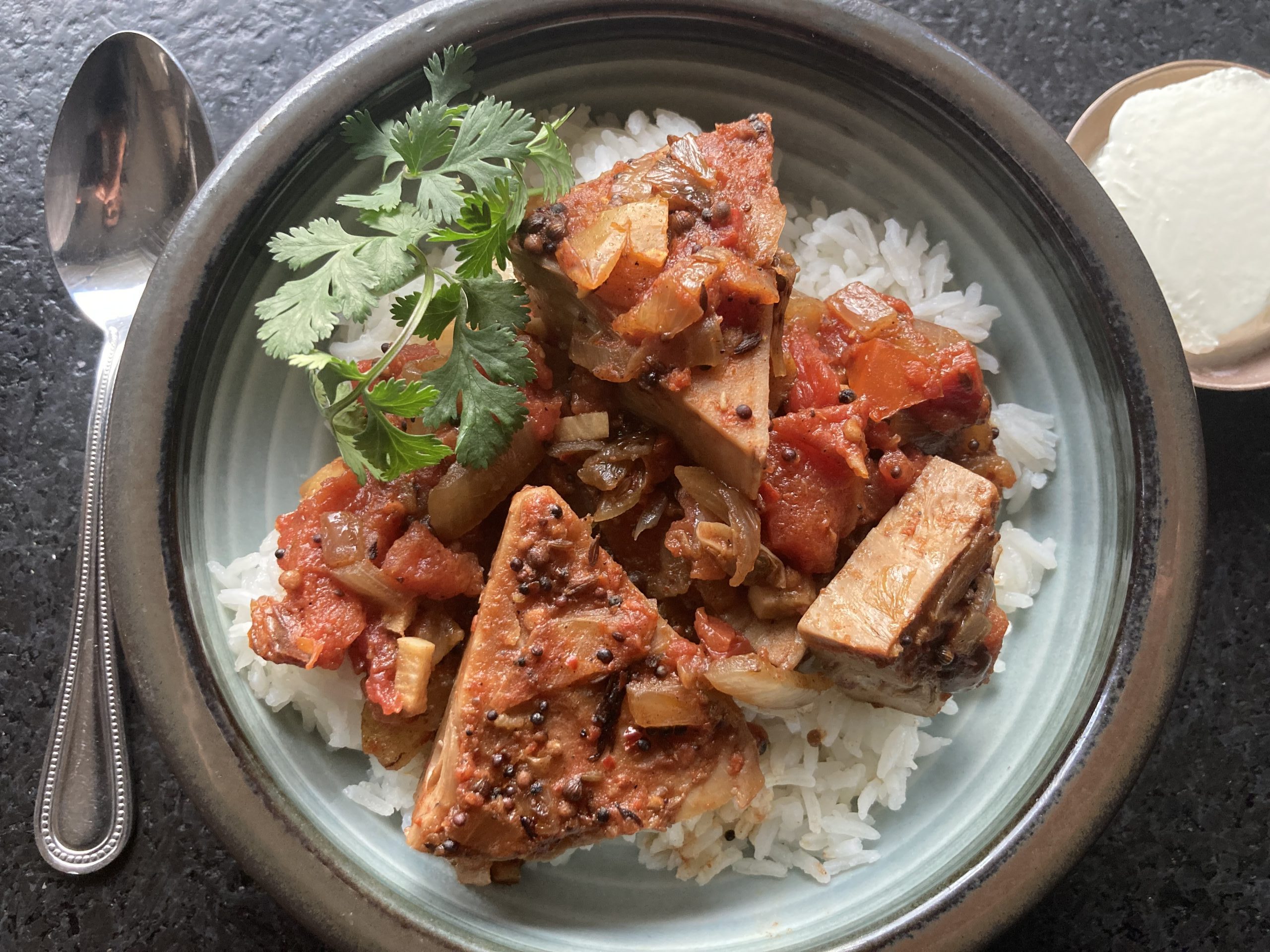
Jackfruit Masala
Jackfruit has become a popular meat alternative in the last few years. It’s popping up on menus and in grocery stores, prepared in many different ways. You can find it on tacos, or on a vegetarian “pulled pork” sandwich at the BBQ joint, and anywhere else meat or proteins are found.
The trees are native to a South Asian region that’s home to the modern countries of Bangladesh, Sri Lanka, India, Burma and Thailand, where it is used widely in sweet and savory dishes. The watermelon-shaped fruit can be three feet long and weigh 100 pounds, and are covered with spikes like an oversized medieval weapon. A single tree can produce as many as 500 fruits in a single year. That’s 50,000 lbs of jackfruit for all of you non-math majors, an astounding amount of food. When mature, the bright yellow flesh is sweet. Younger jackfruit flesh is firmer, closer to white in color, and not sweet at all, tasting somewhere between artichoke heart and mushroom.
In Brazil, where I first encountered jackfruit, I found them to be a bother. The trees are beautiful but menacing, and you had to keep track of them like you did your wallet. You shouldn’t stand beneath that shady canopy, lest you get “jacked” when a dangling bomb lets go, and locals know not to park under them either, as car-jackings are common.
During my time there I never tried eating the young jackfruit, because in Brazil it’s more commonly eaten sweet and ripe. It tastes like extra-fruity bubblegum, with a sticky aroma you can smell a mile away. Altogether I was not impressed.
At an Asian grocery store in Salt Lake City the other day my son snagged a can of jackfruit from the shelf, hoping for a sugary snack, and stuck it in the shopping cart. I didn’t notice until I got home, so I did what I had heard a lot of jackfruit chefs do, and prepared it with habanero huckleberry BBQ sauce. First I simmered it in a cup of sauce and water until the liquid reduced by half. Then I marinated it for three days in the fridge.
I felt sheepish following this path, because I think dressing up “meaty” vegetables to pass as flesh is a set-up for failure. A serving of jackfruit contains less than three grams of protein – six percent of an average daily allowance. Our bodies can taste protein, and lack thereof. When we expect a meaty experience, a meaty texture alone won’t cut it.
And by the same token, if somebody truly loves eating plants, I don’t understand why they would work so hard to pretend it’s meat. Enjoy and celebrate the young jackfruit like the wonderful plant that it is.
Rather than serve my BBQ marinated jackfruit as a “pulled pork” sandwich, I spooned the stringy chunks onto some rice, and ate it like some exotic curry. The mild jackfruit flavor mixed exquisitely with the flavors of the sauce. And the texture of young jackfruit, as others have noted, is fun.
I had a little jackfruit left, so I fried it with some bacon bits, like the omnivore I am. It was glorious. The loose flesh of the fruit soaked up the grease, and the firm, chewy texture created a lovely contrast against the crispy pieces of bacon. I wanted more, and didn’t feel like waiting for Amazon to deliver it to me.
In small town Montana, I didn’t think I’d find jackfruit on the shelves, but I hit the supermarket just in case, and was pleasantly surprised. There was a bag of frozen ripe jackfruit pieces, but that wasn’t the pleasant part. I also found a package of Upton’s Naturals brand “Bar-B-Que Jackfruit,” replete with an image of a bearded hipster on the box. I brought it home to the lab.
The Upton’s Bar-B-Que jackfruit was fine, if inferior to my own creation. But I was ready for something different than pretend meat. In the jackfruit’s ancestral homelands, unripe jackfruit has long been used in savory dishes like curries. I was hoping to make an authentic jackfruit recipe, with spices tailored over many generations specifically for it, and for that I needed unflavored jackfruit. Happily, I found cans of young jackfruit at a small international foods market, and brought some home. To celebrate, I invented a recipe for Indian-style jackfruit masala, a rich gravy with lots of aromatic spices. It doesn’t taste like fruit, and it doesn’t taste like meat. Nonetheless, I can’t stop eating it.
Green Jackfruit Masala
It’s not meat. It’s fried jackfruit in a fragrant tomato gravy. Serve it with rice, a green garnish, and spicy condiments.
Serves 2
¼ cup cooking oil or ghee
1 20-oz can of young jackfruit in brine, drained and cut into pieces about an inch on a side
1 teaspoon garam masala spice powder (or Indian spices of your choice)
1/2 teaspoon whole cumin
1/2 teaspoon whole coriander
1 pinch each of fenugreek and asafoetida if you have them, otherwise don’t stress
1 large onion, chopped
2 cloves garlic, chopped
1 cubic inch of peeled ginger, sliced
1 15-oz can of diced tomatoes, don’t drain the water
zest and juice of a lemon quarter
At serving time: cilantro, yogurt, rice and condiments
Add the oil to the pan and heat it on medium-high heat until a flick of water sputters in the oil. Add the jackfruit pieces to the pan, evenly spaced so they aren’t touching each other, and fry until browned, flipping as necessary.
Remove the browned jackfruit and potatoes and set aside. Lower the heat to medium. Add the garam masala and leave it long enough to almost brown, and then add the onions and stir into the spices. When the onions become translucent add the garlic and ginger. A minute later the tomatoes and the water from the can, and then fill the can with water and add it to. Add the lemon zest and juice. Stir it all together and add salt to taste. Add the browned jackfruit to the sauce, and simmer for 30 minutes to thicken. Serve with a fragrant rice like basmati or jasmine, garnished with chopped cilantro, with yogurt and other condiments within reach.
